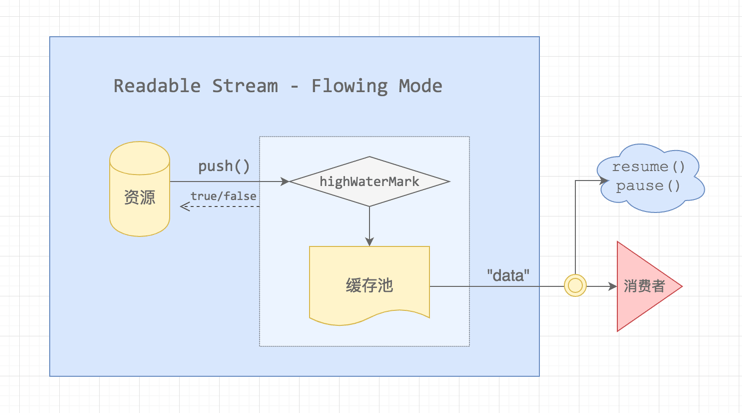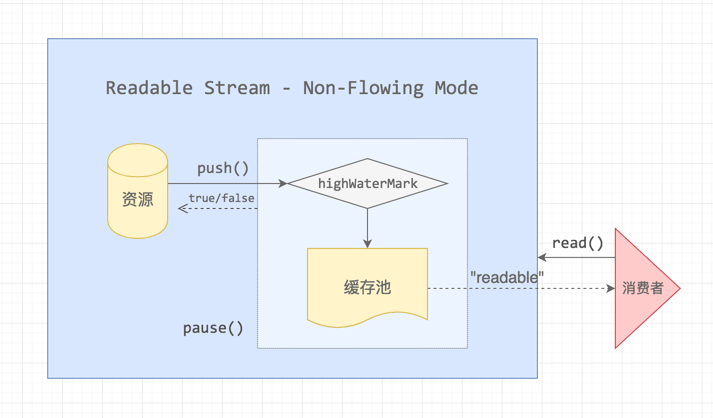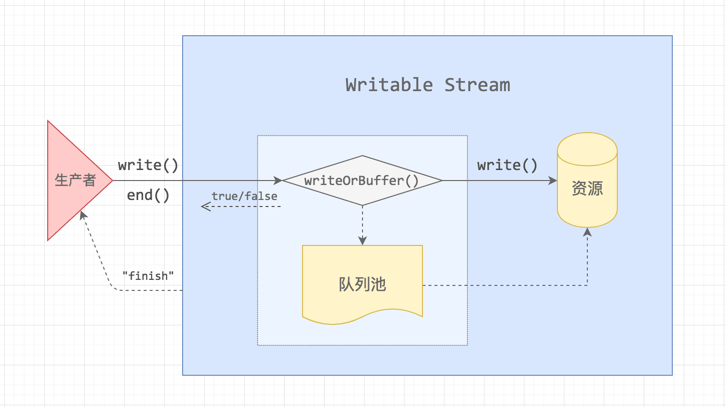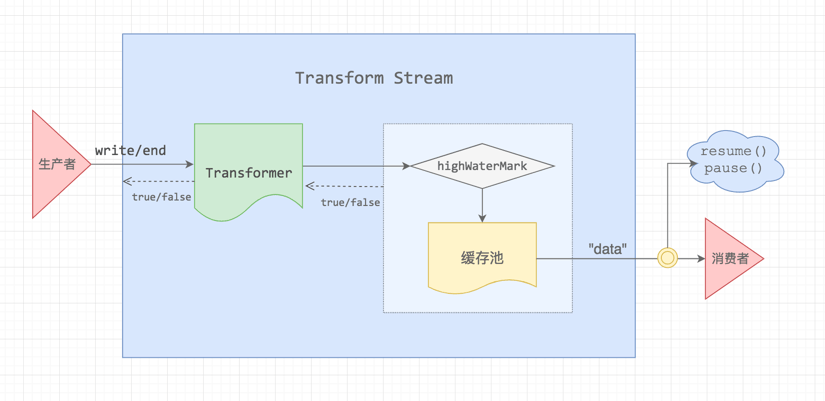深入理解stream
第一篇为 stream入门
要深入理解的话得结合源码来看
// _stream_readable.js
// _stream_writable.js
// _stream_duplex.js
// _stream_transform.js
可读流
可读流的3种状态
-
_readableState.flow = null,暂时没有消费者过来
-
_readableState.flow = false,主动触发了 .pause()
当我们监听了onreadable事件后会进入暂停模式
-
_readableState.flow = true,流动模式
当我们监听ondata事件就会进入流动模式
流动模式

数据先被写入到内存,内存有一个上限highWaterMark,写入时会同时触发data事件,传给消费者。以下2种情况下会触发背压
- 消费者主动执行了 .pause()
- 消费速度比数据 push 到缓存池的生产速度慢
暂停模式

数据写入内存时,会触发readable事件,消费者需要手动调用read方法去内存中读取数据
调用read(size),可以指定字节数,当内存中的数据长度不够时,返回null,够了才一次性读取完
通过API实现可读流
有2种方式
// 通过构造函数
new stream.Readable({
highWaterMark: 16384,
read(){}
})
// 通过es6
class MyReadable extends Readable {
constructor(options) {
// 调用 stream.Readable(options) 构造函数。
super(options);
// ...
}
_read() {
this.push(buf)
}
}
可写流

原理与 Readable Stream 是比较相似的,数据流过来的时候,会直接写入到资源池,当写入速度比较缓慢或者写入暂停时,数据流会进入队列池缓存起来。
当生产者写入速度过快,把队列池装满了之后,就会出现「背压」,这个时候是需要告诉生产者暂停生产的,当队列释放之后,Writable Stream 会给生产者发送一个 drain 消息,让它恢复生产。
背压机制是流内部实现的,当写入内存的速度过快,就会暂停写入。当数据块被处理完成后的回调callback函数,此时触发drain事件,告诉生产者可以继续生产
通过API实现可写流
同理通过构造函数
const myWritable = new Writable({
// 需要注意的是callback必须被回调
// 如果调用失败,则 callback 的第一个参数必须是 Error 对象。 如果写入成功,则 callback 的第一个参数为 null
write(chunk, encoding, callback) {
// ...
}
})
pipe
将可读流和可写流通过管道连接起来
readable.pipe(writable)
可读流将获取的数据,传递给可写流的write
Readable.prototype.pipe = function(dest, pipeOpts) {
// 绑定end事件
this.once('end', () => {
dest.end()
})
// 背压恢复时的回调
dest.on('drain', readable => {
// 流动模式
state.flowing = true
// flow(readable)
while (state.flowing && readable.read() !== null)
})
// 可读流监听
src.on('data', chunk => {
var ret = dest.write(chunk)
if (ret === false) {
src.pause()
}
})
// 触发可写流的pipe事件,告知它有流要写入
dest.emit('pipe', src)
// 可写流可以通过pipe获取写入数据的可读流,实现链式调用
return dest
}
双工流
查看源码我们发现,Duplex是继承Readable的
util.inherits(Duplex, Readable)
同时拥有Writable原型上的所有方法
{
// Allow the keys array to be GC'ed.
const keys = Object.keys(Writable.prototype);
for (var v = 0; v < keys.length; v++) {
const method = keys[v];
if (!Duplex.prototype[method])
Duplex.prototype[method] = Writable.prototype[method];
}
}
那我们可以发现,可读流与可写流之间是没有直接联系的,也就是说一个双工流也可以是只读流、只写流、还有一种称为半工流(也就是只读或者只写)
// 通过参数控制
if (options) {
if (options.readable === false)
this.readable = false;
if (options.writable === false)
this.writable = false;
if (options.allowHalfOpen === false) {
this.allowHalfOpen = false;
this.once('end', onend);
}
}
// the no-half-open enforcer
function onend() {
// If the writable side ended, then we're ok.
if (this._writableState.ended)
return;
// no more data can be written.
// But allow more writes to happen in this tick.
process.nextTick(onEndNT, this);
}
function onEndNT(self) {
self.end();
}
可以看出allowHalfOpen先判断可写流是否end,如果不是则手动调用可读流end:this.end(),因为this指向readable。
转换流

它是直接继承的双工流
util.inherits(Transform, Duplex)
// 然后支持传递transform和flush函数重写转换
if (options) {
if (typeof options.transform === 'function')
this._transform = options.transform;
if (typeof options.flush === 'function')
this._flush = options.flush;
}
实现转换流的例子,可读流与可写流的关联在内部实现了,暴露给我们的_transform和_flush方法,只需要将数据经过处理后push并回调即可。
const Transform = require('stream').Transform;
const MAP = {
'Barret': '靖',
'Lee': '李'
};
class Translate extends Transform {
constructor(dataSource, options) {
super(options);
}
_transform(buf, enc, next) {
const key = buf.toString();
const data = MAP[key];
this.push(data);
next();
}
}
var transform = new Translate();
transform.on('data', data => console.log(data.toString()));
transform.write('Lee');
transform.write('Barret');
transform.end();
关于_flush,查看源码可以发现,通过prefinish事件触发,也就是说我们可以手动emit('prefinish'),来触发_flush
flush(callback) {
// 正常时error为null
// data为你额外需要写入流的数据
callback(error, data)
}
function prefinish() {
if (typeof this._flush === 'function' && !this._readableState.destroyed) {
this._flush((er, data) => {
done(this, er, data);
});
} else {
done(this, null, null);
}
}
function done(stream, er, data) {
if (er)
return stream.emit('error', er);
if (data != null) // single equals check for both `null` and `undefined`
stream.push(data);
return stream.push(null);
}